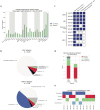This is a preprint.
Improving diagnosis of non-malarial fevers in Senegal: Borrelia and the contribution of tick-borne bacteria
- PMID: 37662407
- PMCID: PMC10473814
- DOI: 10.1101/2023.08.24.23294564
Improving diagnosis of non-malarial fevers in Senegal: Borrelia and the contribution of tick-borne bacteria
Abstract
The worldwide decline in malaria incidence is revealing the extensive burden of non-malarial febrile illness (NMFI), which remains poorly understood and difficult to diagnose. To characterize NMFI in Senegal, we collected venous blood and clinical metadata from febrile patients and healthy controls in a low malaria burden area. Using 16S and unbiased sequencing, we detected viral, bacterial, or eukaryotic pathogens in 29% of NMFI cases. Bacteria were the most common, with relapsing fever Borrelia and spotted fever Rickettsia found in 15% and 3.7% of cases, respectively. Four viral pathogens were found in a total of 7 febrile cases (3.5%). Sequencing also detected undiagnosed Plasmodium, including one putative P. ovale infection. We developed a logistic regression model to distinguish Borrelia from NMFIs with similar presentation based on symptoms and vital signs. These results highlight the challenge and importance of improved diagnostics, especially for Borrelia, to support diagnosis and surveillance.
Conflict of interest statement
Competing Interests P.C.S. is a co-founder of, shareholder in, and consultant to Sherlock Biosciences, Inc. and Delve Bio, as well as a Board member of and shareholder in Danaher Corporation.
Figures




References
-
- World Bank. Incidence of malaria (per 1,000 population at risk). (2021).
-
- WHO. Who informal consultation on fever management in peripheral health care settings a global review of evidence and. (2013).
Publication types
Grants and funding
LinkOut - more resources
Full Text Sources
